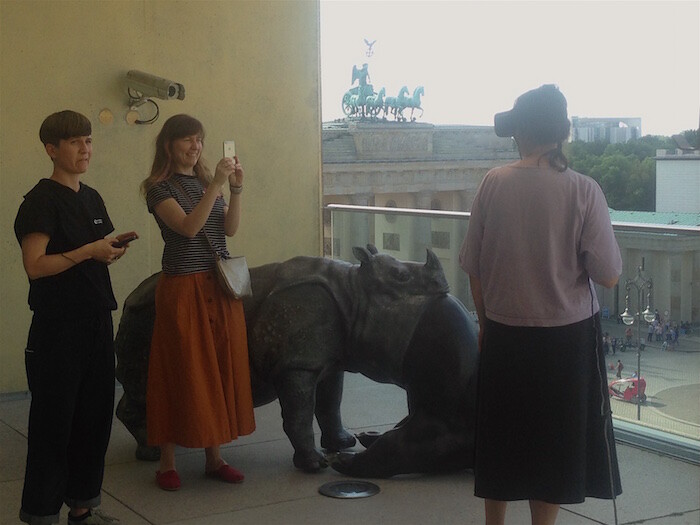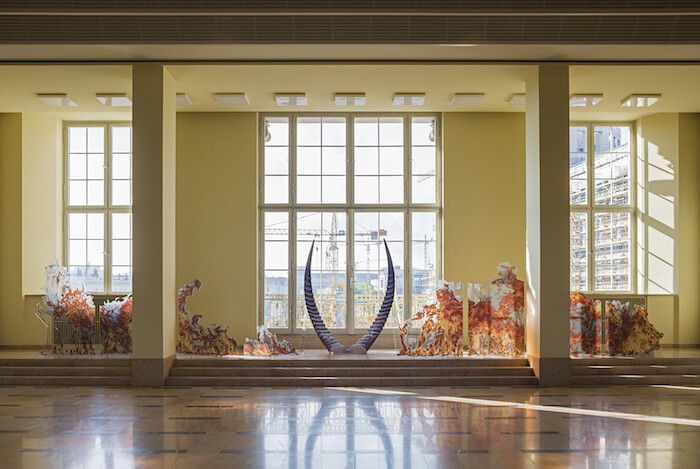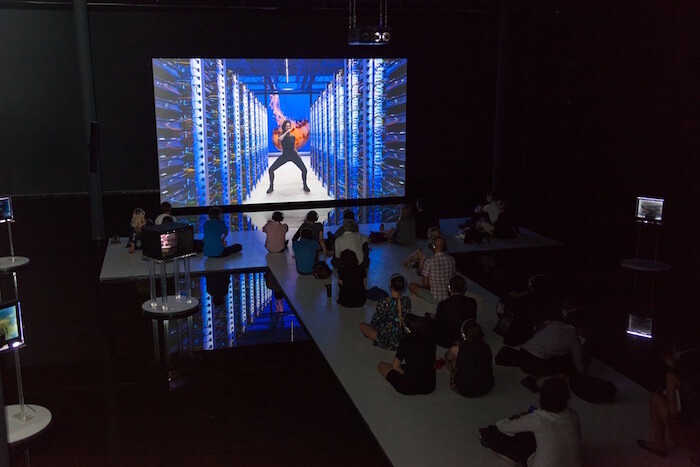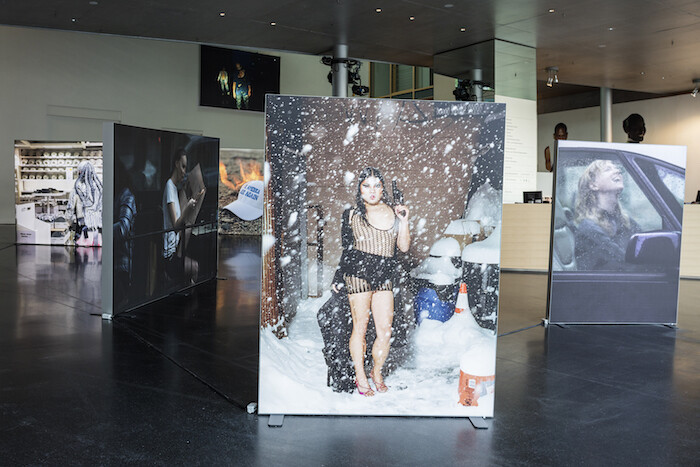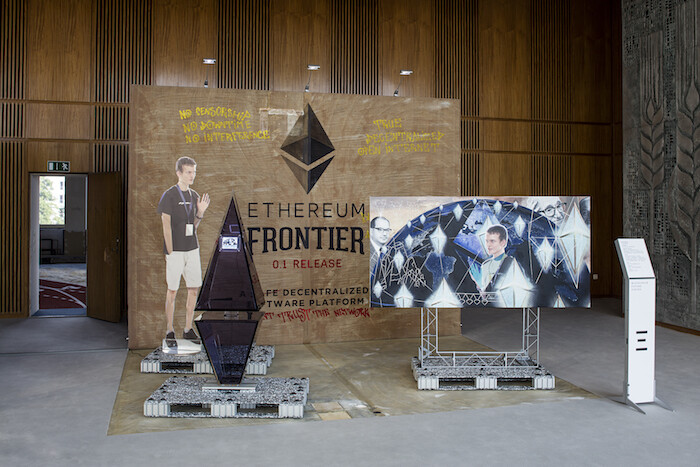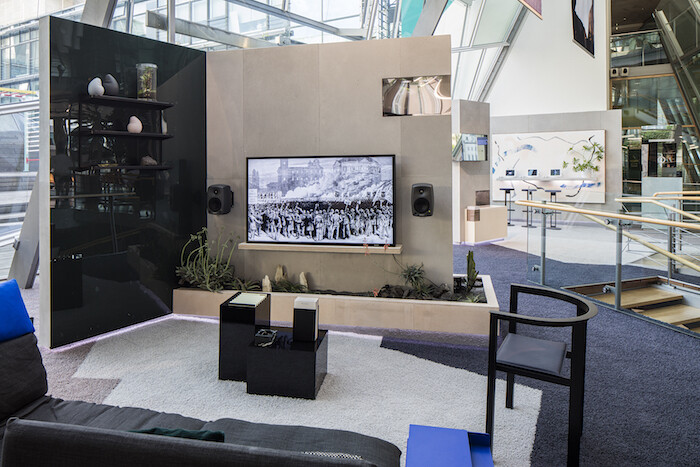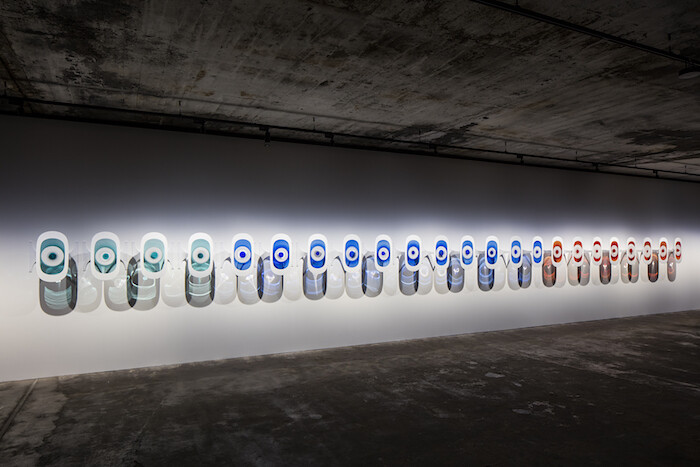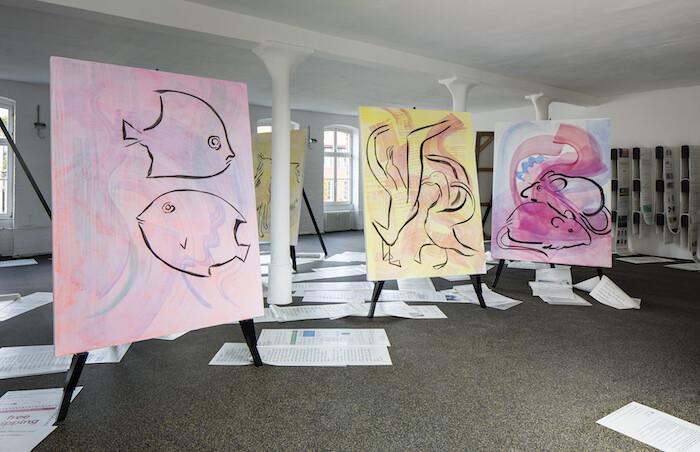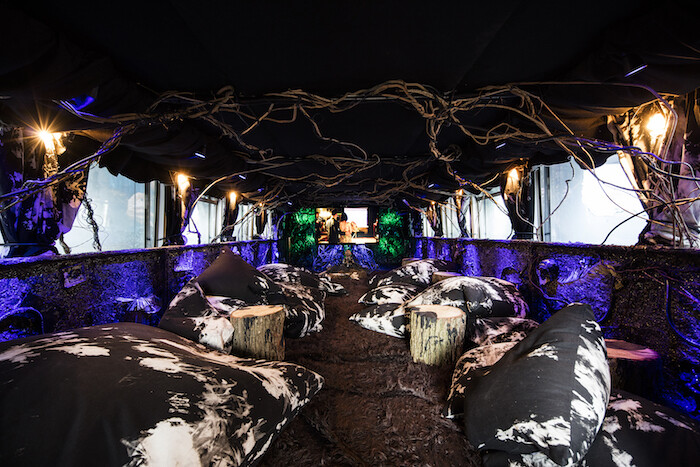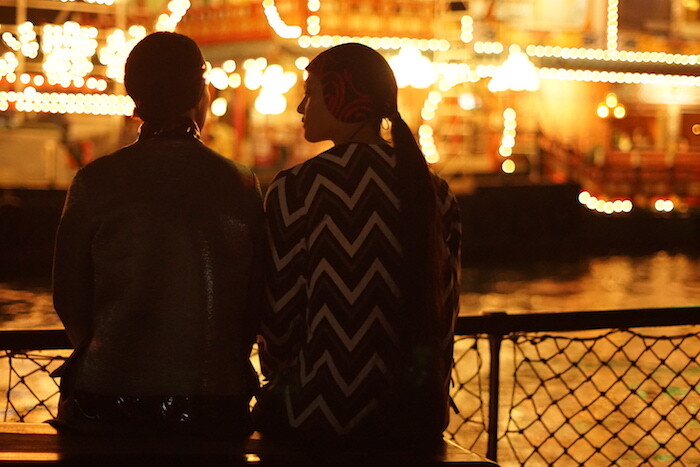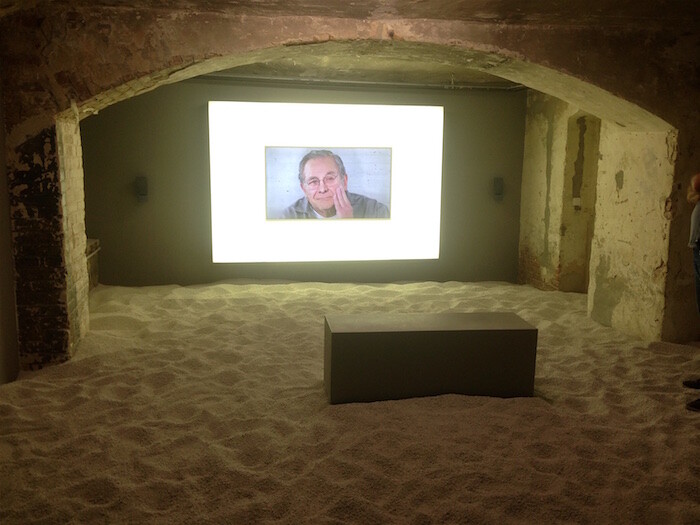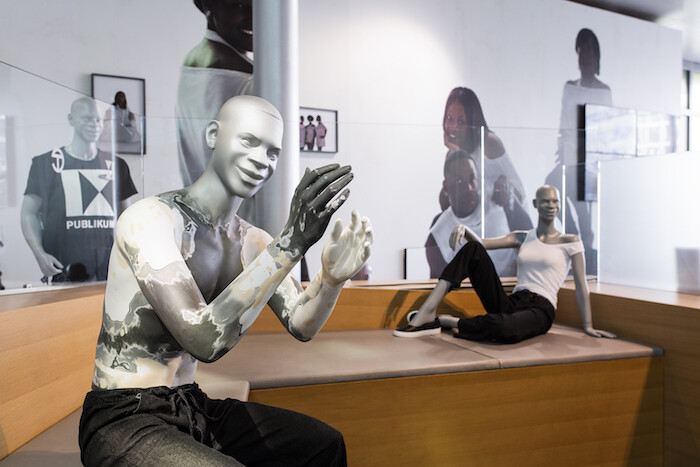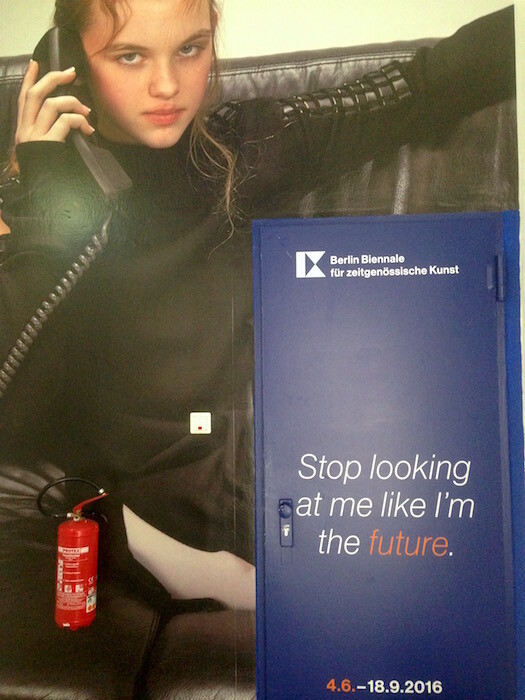“Advertisting … is the only art form we [in the United States] ever invented.” Gore Vidal 1
The fourth floor of Berlin’s Akademie der Künste overlooks Pariser Platz: the Brandenburg Gate, the French embassy fringed with barricades, a teeming Starbucks. Tourists mill around the square, while up on the mezzanine, between a set of marble statues of animals improbably swallowing other animals, a queue forms behind an Oculus Rift rig: Jon Rafman’s View of Pariser Platz (2016). At first the rendered scene in the headset matches the architecture and sculptures. A dog gags on a lion, an iguana gulps a sloth. Slowly, the animals start swelling, expelling, gyrating; the view fills with fog. Human figures blow upwards like flapping skins. Soon the pavement and building break apart; the viewer freefalls among the debris, landing, after a moment, among ranks of featureless mannequins… Rafman’s technical hallucination takes roughly three minutes. For three minutes, the setting in all its very real paradox—a symbolic gateway between West and East, Reagan and Gorbachev, also known as the place where Michael Jackson dangled his baby from a balcony—falls away beneath an encompassing, scripted but nonreactive spectacle. Thus the city rebrands itself: a new ad on a dirty bus stop, trendy clothes on a chipped mannequin, a twenty-first-century ideology on a pockmarked prewar building.
The digital media platform DIS comes to Berlin as four curators programming a biennial and as young New Yorkers interpreting a foreign town—but also as an image all its own. Accordingly, many of the works in the 9th Berlin Biennale seem not to disturb their context so much as augment, sex up, imitate, and artify. At the European School of Management and Technology (ESMT), one of five official venues scattered throughout the city, Katja Novitskova has installed acrylic standees printed with horns and flames; one group, superimposed on a first-floor window, appears to lick at a thicket of nearby construction cranes (Expansion Curves (fire worship, purple horns), 2016). This much, at least, satirizes more self-satisfied didactic art, while still managing to raise the specter of a gentrifying city. Most other works are more ambivalent. At the KW Institute for Contemporary Art, the fashion label 69 has reupholstered a few hanging chairs in denim (69 R&R, 2016); even if visitors notice, the material is unlikely to evoke, as the artists would have it, everything from blue collar jobs to sweatshops to the hipsters that wear designer workwear to biennials. A clip from Amalia Ulman’s PRIVILEGE (2016) provides an even more vacant take on the exhibition’s title, “The Present in Drag”: an “old crone” effect overlaid on the artist’s eternally youthful face.
While little here presents as substantive, let alone sacred (the video What the Heart Wants [2016], a gauzy cyber romance by Cécile B. Evans, is one exception), the DIS brand itself offers the Berlin Biennale’s most forceful proposition. Add to the art in the official venues: a series of lightboxes (“LIT”); several musical collaborations (“Anthem”); a thoroughly designed web and social media presence; and a dense, intelligent catalog. Listed in exhibition materials as “Not in the Berlin Biennale” are the paratexts and ads and other finishing touches that make the Biennale a coherent, even compelling brand experience. (Roe Ethridge, for instance, shot the photos in the brochures.) Under DIS, gestures that would tip into banality or plain narcissism in another context—Josephine Pryde’s photographs of hands and devices (Hands “Für mich,” 2014–16) at the Feuerle Collection, or Wu Tsang’s meta-Orientalist, quasi-revisionist video installation (Duilian, 2016) at the KW—feel like profound emblems of the zeitgeist. Never mind how ironically consumerist, sincerely complicit, and cynically new-agey that zeitgeist is. Advertising’s immemorial claim remains: if you’re not buying, you don’t get it.
Yet this entrepreneurial confidence rests like denial on the old world. For Blockchain Visionaries (2016), installed at the ESMT (once an East German government building, now a management school), Simon Denny has mounted a miniature trade show for three actual companies promoting blockchain technology—from privatized, bespoke security for existing financial markets; to a Bitcoin-based centralized protocol; to a decentralized, nodal anarchism. A fourth element dominates the room: an extant Soviet-era steel relief of a cooling tower, a dove, two stalks of grain. Indeed, the blockchain promises the same nonhierarchical, impartial security as the Communist state; yet where Stalin refused to wither away, Bitcoin is already headless. At the AdK, a video installation by Christopher Kulendran Thomas (New Eelam, 2016) makes a similar case in the guise of an ad for a fictitious but plausible “housing subscription” service. Paraphrasing existence as capital, the narrator extolls a “liquid form of citizenship”: no citizens, but subscribers; no nations, but brands. The name references the Liberation Tigers of Tamil Eelam, an armed utopian group in Sri Lanka violently crushed in 2009 by the Western-backed government. Investors in the cultural sector next waged what the narration calls a “soft ethnic cleansing.” Might technological revolution succeed where the militant fails? Maybe—but no brand of collectivity is without an agenda. More to the point: ironic or not (and we’re not sure it is), to spin ethnic cleansing as a lifestyle choice is spectacular bad taste.
Here lies the danger in shelving an aspirational future in favor of a self-evident, inevitable now: if the future is just the present in drag, future thinking may as well be totally outmoded. A precious few works explore what it means to take a progressive position. The top floor of the KW is given over to Camille Henrot’s Office of Unreplied Emails (2016); scattered between breathy, bright paintings of kissing animals are dozens of silicone prints of thoughtful but exhausted replies to the likes of the Sierra Club and Uber. In the KW’s bunker-like basement, Josh Kline’s video Crying Games (2016) stages a wishful kind of propaganda. Actors digitally masked as Dick Cheney, Donald Rumsfeld, Condoleezza Rice, George Bush Jr., and Tony Blair sob in regret over the Iraq War. “I’m so sorry,” they moan, “all those people…” Here, technology achieves exactly this: a simulation of the apology we deserve but will never get—and that wouldn’t help anyway.
How much easier, says DIS, to embrace our complicity. Each of the five hangs more or less parallels the expectations of its host institution—cueing that their codes have been understood, not scrambled. At the AdK, ad-like works occupy the ancillary spaces of advertising and signage. A Blue-Star tour boat on the Spree, decorated by artists Korakrit Arunanondchai and Alex Gvojic, is still a tour boat. At the Feuerle Collection, a waterfront bunker barely converted for art, Yngve Holen presents a series of “evil eyes,” artisanal blown-glass airline windows in powder-coated Apple-type settings. Stretched out in a row spaced to match the layout of a Boeing 787, a work such as Window seat 42–43 F (2016) looks like collector bait—and it is. Forget the droll stakes, or lack thereof, for whatever jet set precariat. When things get too urgent, too specific, too earnest—all that advertising really proposes is that you buy in. For Suprem(e), a fashion line by Bjarne Melgaard in collaboration with skateboarding clothing brand Supreme, the covers of even such left-justified Semiotext(e) tracts as The Invisible Committee’s The Coming Insurrection (2007) become embroidery on puffy streetwear. Brands subsume brands like Russian dolls, with DIS as the outermost layer.
But then you leave, and you fly straight home from TXL in an aisle seat, or you walk around a postmodern Berlin suffused with lifestyle adverts as caustic and beautiful as anything in a reality augmented by DIS. DIS understands art’s redundancy. It would therefore rather be something else. Yet theirs is less a critical position than a bid for self-preservation—a final return to future thinking. In this, too, DIS synthesizes a sense of gagging optimism, like an image lewdly trying to python a city but unable to swallow, that feels nothing if not now.
Gore Vidal, from an interview with David Barsamian for The Progressive (October 2006), http://www.progressive.org/mag_intv0806.

